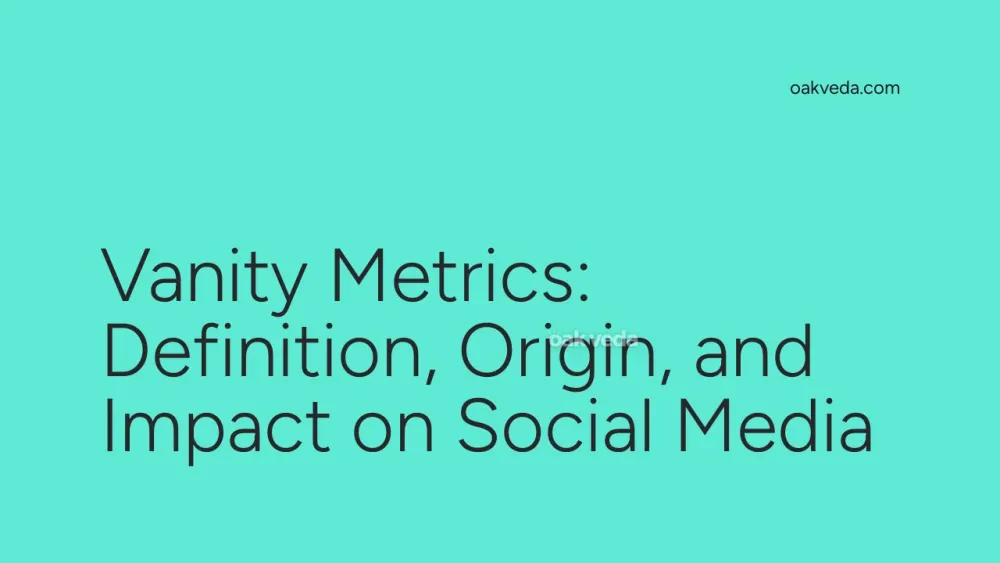
What are Vanity Metrics?
Vanity metrics are quantitative measurements in social media and digital marketing that appear impressive on the surface but often lack substantial value in terms of business performance or strategic decision-making. These metrics typically focus on easily trackable numbers that may boost ego or create a false sense of success without necessarily correlating to meaningful outcomes or ROI.
Origin and Development of Vanity Metrics
The concept of vanity metrics gained prominence in the early 2010s as social media platforms and digital marketing tools proliferated. Eric Ries, author of "The Lean Startup," is often credited with popularizing the term. As businesses rushed to establish their online presence, the need to measure digital success led to an overemphasis on easily obtainable numbers, giving birth to the vanity metrics phenomenon.
How Vanity Metrics Work
Vanity metrics work by providing easily digestible numbers that often show growth or engagement. These metrics are typically:
- Easy to measure
- Visually impressive
- Often growing over time
However, they frequently fail to provide actionable insights or demonstrate real business impact. For example, a high number of followers doesn't necessarily translate to increased sales or brand loyalty.
Types of Vanity Metrics
Common vanity metrics in social media include:
- Follower count
- Likes
- Shares
- Comments
- Impressions
- Page views
While these metrics can offer some value, relying on them exclusively can be misleading.
Popular Examples of Vanity Metrics
- Instagram followers: A high follower count doesn't guarantee engagement or influence.
- Facebook page likes: Pages with millions of likes may still struggle with actual engagement.
- Twitter retweets: While they increase visibility, retweets don't necessarily lead to conversions.
- Website traffic: High traffic doesn't always correlate with conversions or revenue.
Impact of Vanity Metrics on Social Media Culture
Vanity metrics have significantly influenced social media culture:
- Pressure for popularity: Users and brands feel compelled to amass large followings.
- Quantity over quality: The focus shifts from meaningful interactions to sheer numbers.
- Misleading success indicators: Brands may overvalue their social media performance based on these metrics.
- Algorithm manipulation: Some users employ tactics to artificially inflate these numbers.
Controversies Surrounding Vanity Metrics
The reliance on vanity metrics has sparked debates in the marketing world:
- Authenticity concerns: High numbers may be achieved through inauthentic means (e.g., buying followers).
- Misallocation of resources: Businesses may invest heavily in boosting vanity metrics at the expense of more meaningful goals.
- Skewed perceptions: Influencers with inflated metrics may mislead brands about their actual reach and impact.
How Brands and Influencers Use Vanity Metrics
Despite their limitations, vanity metrics are still widely used:
- Social proof: High follower counts can lend credibility to brands and influencers.
- Benchmarking: Companies use these metrics to compare themselves against competitors.
- Quick performance indicators: They provide easily understandable snapshots of social media presence.
- Attracting partnerships: Influencers often use these metrics to secure brand collaborations.
Alternatives to Vanity Metrics
To gain more meaningful insights, focus on:
- Engagement rate: Measures the percentage of followers interacting with content.
- Conversion rate: Tracks the percentage of users taking desired actions.
- Customer Lifetime Value (CLV): Estimates the total value a customer brings over their relationship with the brand.
- Return on Investment (ROI): Measures the profitability of social media efforts.
- Sentiment analysis: Evaluates the tone and emotion behind social media interactions.
Future Trends Related to Vanity Metrics
The future of social media metrics is likely to see:
- Increased focus on quality over quantity: Platforms may prioritize meaningful engagement in their algorithms.
- Advanced analytics tools: More sophisticated tools will emerge to measure true impact and ROI.
- Transparency in influencer marketing: Brands may demand more concrete proof of influencers' impact beyond follower counts.
- Shift towards micro and nano-influencers: Focus may move to smaller, more engaged audiences.
FAQs about Vanity Metrics
-
Are vanity metrics completely useless? No, they can provide some insights, but they shouldn't be the sole focus of your strategy.
-
How can I move beyond vanity metrics? Focus on metrics that align with your business goals, such as conversion rates, customer retention, and revenue growth.
-
Can vanity metrics ever be valuable? Yes, in certain contexts. For example, a rapidly growing follower count might indicate successful brand awareness campaigns.
-
How do I explain the limitations of vanity metrics to stakeholders? Demonstrate how these metrics don't necessarily correlate with business outcomes and showcase more meaningful KPIs that directly impact the bottom line.
By understanding the role and limitations of vanity metrics, businesses and individuals can develop more effective social media strategies that focus on meaningful engagement and tangible results. While these metrics may still have a place in the social media landscape, it's crucial to look beyond the surface numbers to truly gauge success and drive impactful outcomes.
You may be interested in:
- Access Group: Definition, Origin, and Impact on Social Media
- Creator Economy: Definition, Origin, and Impact
- Fire: Definition, Origin, and Impact in Social Media
- Social Media Monitoring: Definition, Origin, and Impact
- SMH: Definition, Origin, and Impact on Social Media
- YouTube Shorts: Definition, Origin, and Impact

